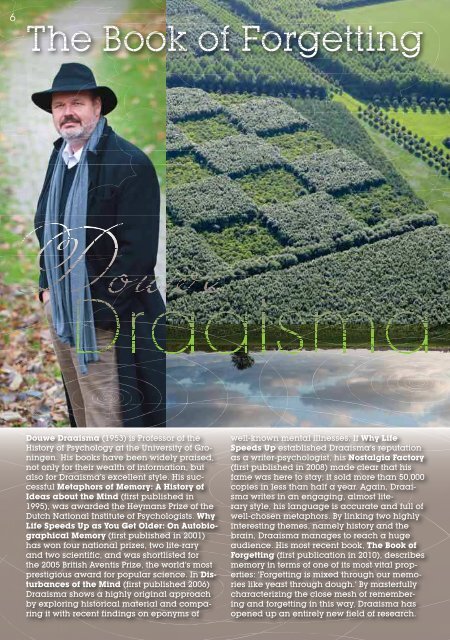IN THE MORE THAN - Historische Uitgeverij
IN THE MORE THAN - Historische Uitgeverij
IN THE MORE THAN - Historische Uitgeverij
You also want an ePaper? Increase the reach of your titles
YUMPU automatically turns print PDFs into web optimized ePapers that Google loves.
6<br />
The Book of Forgetting<br />
Douwe Draaisma (1953) is Professor of the<br />
History of Psychology at the University of Groningen.<br />
His books have been widely praised,<br />
not only for their wealth of information, but<br />
also for Draaisma’s excellent style. His successful<br />
Metaphors of Memory: A History of<br />
Ideas about the Mind (first published in<br />
1995), was awarded the Heymans Prize of the<br />
Dutch National Institute of Psychologists. Why<br />
Life Speeds Up as You Get Older: On Autobiographical<br />
Memory (first published in 2001)<br />
has won four national prizes, two lite-rary<br />
and two scientific, and was shortlisted for<br />
the 2005 British Aventis Prize, the world’s most<br />
prestigious award for popular science. In Disturbances<br />
of the Mind (first published 2006)<br />
Draaisma shows a highly original approach<br />
by exploring historical material and comparing<br />
it with recent findings on eponyms of<br />
well-known mental illnesses. If Why Life<br />
Speeds Up established Draaisma’s reputation<br />
as a writer-psychologist, his Nostalgia Factory<br />
(first published in 2008) made clear that his<br />
fame was here to stay; it sold more than 50,000<br />
copies in less than half a year. Again, Draaisma<br />
writes in an engaging, almost literary<br />
style, his language is accurate and full of<br />
well-chosen metaphors. By linking two highly<br />
interesting themes, namely history and the<br />
brain, Draaisma manages to reach a huge<br />
audience. His most recent book, The Book of<br />
Forgetting (first publication in 2010), describes<br />
memory in terms of one of its most vital properties:<br />
‘Forgetting is mixed through our memories<br />
like yeast through dough.’ By masterfully<br />
characterizing the close mesh of remembering<br />
and forgetting in this way, Draaisma has<br />
opened up an entirely new field of research.<br />
U N L I K E H I S E A R L I E R Why Life Speeds Up as You Get Older and Nostalgia Factory,<br />
Douwe Draaisma’s new book, The Book of Forgetting, does not centre on the puzzling logic of<br />
memory, but on the wonder of forgetting. Forgetting, says Draaisma, serves a purpose. It is not<br />
a defect of our memory, but one of its main strengths. Forgetting is mixed through our memories<br />
like yeast through dough. The ‘first memory’ not only marks the beginning of our memory, but<br />
also highlights the forgotten years that preceded it. Memory would not remember anything if it<br />
did not selectively erase as well.<br />
In The Book of Forgetting Draaisma once again demonstrates his talent for combining<br />
literary and scientific sources in a way that is both original and light-footed. Novels, films, paintings<br />
and photos alternate with examples from psychology, psychiatry, neurology and philosophy.<br />
Almost casually he thus reveals how forgetting works, and exposes persistent clichés. Like<br />
the idea that photos can refresh one’s memory: ‘A photo needs memories to be a real representation.’<br />
Much more often the image of the photo slides in front of the real faces of old friends or<br />
lost loved ones. As for dreams, he drily remarks that it cannot be their mysteriousness that makes<br />
them so easy to forget. ‘In real life, if I suddenly found myself in the basement with the gorgeous<br />
lady from next door, I would certainly remember it a week after, all the more so because we<br />
don’t have a basement.’<br />
Draaisma is at his best when he raises questions which immediately seem important,<br />
but which you are surprised to realize you have never considered. Why, for instance, are there<br />
techniques for remembering but not for forgetting? Where do repressed memories reside? What<br />
happens to shared memories when the person you shared them with is no longer around? Can<br />
memory traces really disappear from our brain or do we ‘forget’ because these tra-ces are no<br />
longer accessible? Can ‘hypnosis’ bring<br />
back ‘forgotten memories’? Why do portraits,<br />
painted or photographed, tend to<br />
erase our memories of faces? How come<br />
a colleague remembers your idea, but<br />
has forgotten that it was your idea? This<br />
danger is certainly present in The Book of<br />
Forgetting. Its ideas are so convincing that<br />
you almost forget you read them first in<br />
Draaisma.<br />
Publishing details<br />
Douwe Draaisma<br />
Vergeetboek<br />
ISBN 978-90-6554-055-3<br />
280 pp., 25 (black and<br />
white) illustrations<br />
40,000 copies sold<br />
Forthcoming translations<br />
Wydawnictwo Aletheia<br />
(Poland)<br />
Eco-Livres (Korea)<br />
Galiani Berlin (Germany)<br />
Gondolat Kiadó (Hungary).<br />
7




